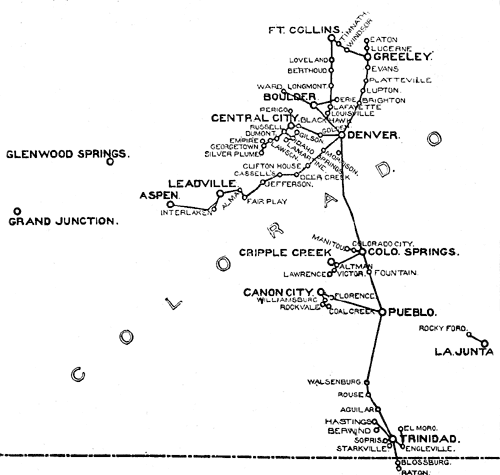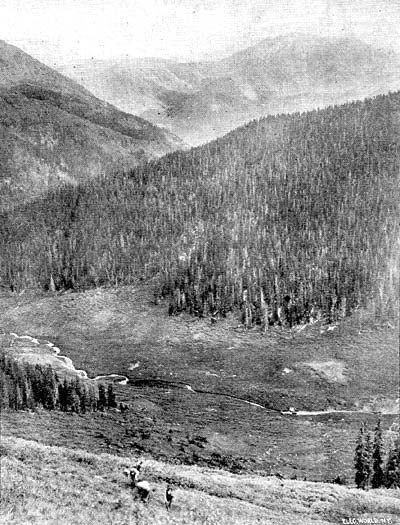Telephone Construction in Colorado Rocky Mountains
|
[Trade Journal] Publication: Electrical World New York, NY, United States |
|||||||||||||||
|
Telephone Construction in the Rocky Mountains. BY J. W. DICKERSON.
The Colorado Telephone Company owns and operates a connected system that furnishes communication between all important points in the heart of Colorado. The main trunk or division lies substantially north and south, as is shown in the map of the system, Fig. I. It extends as far south, as Raton in New Mexico, while the Northern terminus is Eaton, within 25 miles of the Wyoming line. Branches extend from the main trunk to all places of consequence as far west as Aspen. The company also owns a comparatively short connected system in New Mexico with Las Vegas as a centre. Isolated exchanges are maintained in several cities and towns, some of which may in time be connected with the long-distance system. The headquarters of the company are in Denver, where the telephone building, located on Lawrence Street, is one of the most commodious, convenient and best arranged structures of the kind to be found anywhere.
Of the 664 miles of pole line owned by the company, at least 300 miles have been built in mountainous districts, and in the extensions of the system in these localities the most interesting features of its construction are to be found. The building of these mountain lines has been expensive, as many difficulties have had to be surmounted, but the great outlay has, as a rule, been justified and has been appreciated by the public. The service is liberally patronized, so liberally indeed that the existing facilities are greatly overtaxed at some points, and plans for adding new circuits and providing additional improvements of various kinds are under consideration. During the last year the most important move executed by the company was the construction of the line from Leadville to Aspen, which, as has already been stated, is the most westerly point now reached by the long-distance system. The line was built last Summer, and for the construction almost two months were required. In an air line Leadville is located about 32 or 33 miles from Aspen, but the telephone line built over the mountains necessarily follows a somewhat circuitous route and is 48 miles in length. The poles are located along the wagon road for considerable distances, but at many points short cuts are taken, the poles being then set on grades too steep for vehicles to surmount. The line is, therefore, much shorter than the wagon road and its total length is hardly more than one third that of the railway which connects the two cities. In the ordinary construction the poles are set 42 to the mile, but at certain points where sharp turns are necessary the number is sometimes increased to as many as 75 per mile. When timber is encountered it is necessary that a path should be cleared for a distance of 200 feet on each side of the line, in order that wires may not be broken when trees are blown over by the extraordinary gales which sometimes prevail. For this reason it is essential that the members of the construction gang should be expert choppers as well as linemen.
The preparation of the holes for the poles is a slow and fatiguing process, especially when undertaken on high altitudes. Ordinarily it is necessary to blast a place for the pole by the use of giant powder, and one man in the employ of the company, an ex-miner who has had an extensive experience with explosives, is especially assigned to work of this class. On the Leadville-Aspen line not less than 300 pounds of giant powder were used for this purpose. Under these conditions to dig a pole hole is often a hard day's work for an industrious man. The difficulty of preparing lodgment for the poles is not the only cause for slowness in prosecuting construction on the mountains. Any prolonged effort in the extreme altitudes is exceedingly exhausting. At one point in the Leadville-Aspen line the wires are strung at an elevation of 12,000 feet above sea level. In such an altitude the lineman soon becomes completely tired out; and after he has climbed two or three poles he is ready for a period of rest in which to recuperate his energies. The poles, which are native grown, are usually 25 feet high and are buried five feet. They are drawn up the mountain roads to points above those where they are to be finally placed, and are then "snaked" down by the men as they are required.
When the Continental Divide was reached on the Leadville-Aspen line poles were abandoned, and the circuit was continued by means of a cable buried in a two-foot trench for a distance of 7600 feet. The cable is of the unarmored, submarine type, and was furnished by the Standard Underground Cable Company. Fig. 3 shows part of the district in which the cable is located, workmen being shown engaged in the excavation for the trench. The advisability of abandoning aerial construction at this point was demonstrated by the experience required by the company in maintaining the Denver & Leadville line. At Mosquito Pass, on that line, the poles were originally set 100 feet apart. As soon as the wires were covered with sleet they promptly snapped, and the line was useless. Double the number of poles were then used, but the result was not different. As a further experiment poles were set every 15 feet, but the No. 6 wire failed to hold up when the sleet began to accumulate upon it. The necessity of introducing radically different construction became evident, and a Standard underground cable was used for two and a half miles. No trouble has since been experienced with the line. One is' not surprised to learn that the aerial wire failed when one hears the stories of ice-accumulation on the wires from men who have had experience with mountain telephone lines. The foreman of the construction gang remarked to the writer when questioned about the difficulty: "Why, man, the sleet comes down Mosquito Pass in such a way that a telephone wire would be as big around as your body in no time." When trouble is encountered on these mountain lines during the Winter season the linemen who are sent out to locate it and make repairs must make their journey on snowshoes. If they are overtaken by a storm or find they must remain out over night, they push on r the nearest refuge, which is ordinarily a deserted cabin formerly occupied by some prospector or miner. All the poles are numbered and the linemen are furnished with maps, showing that shelter of some kind can be found near poles of certain numbers. The construction gang which built the line from Leadville to Aspen last Summer comprised 30 men, who camped out at night in tents, and the t able was under the charge of a cook and an assistant attached to the expedition. One of the members of the party is authority for the assertion that the bill of fare was much more attractive than that encountered at any of the hotels along the line. The work was done during the months of July and August, and for the most part pleasant weather favored the progress of the work. Every night ice was formed in the creeks along the way, so that clothing warmer than that usually essential in Summer necessarily formed part of the equipment. While tents were ordinarily occupied. at night the party on one occasion enjoyed the luxury of sleeping in houses. Fourteen miles east of Aspen the gang took possession of the deserted village of Independence, a town which in 1881 boasted of a population of 1000, but which fell into decay when the stage line abandoned it. The visitors revived the memories of municipal life by holding a mock election at which a temporary mayor was elected. No ghosts haunting the deserted homes disturbed the hard-earned rest of the unimpressionable linemen. Fig. 2 shows some curiosities in the way of poles which were once to be seen in the vicinity of Leadville, and were used by a company whose rights have been acquired by the Colorado Telephone Company. These extraordinary poles were old trees, which were used for carrying cross-arms, as they happened to grow at points where supports for wires were required. It will be seen that they were made to carry as many as 12 and 15 wires. They have now been replaced by poles of the standard pattern of the company.
|



